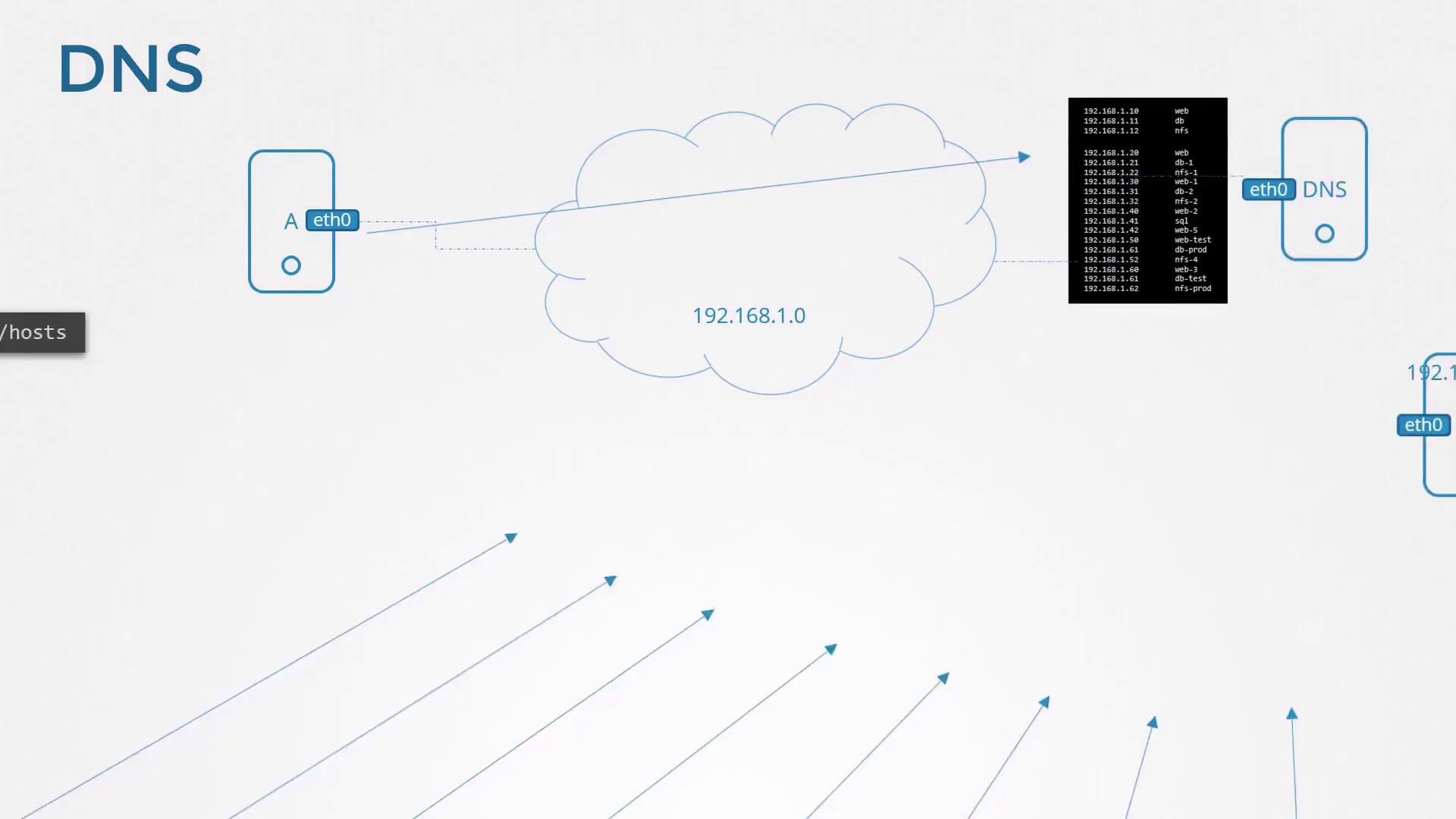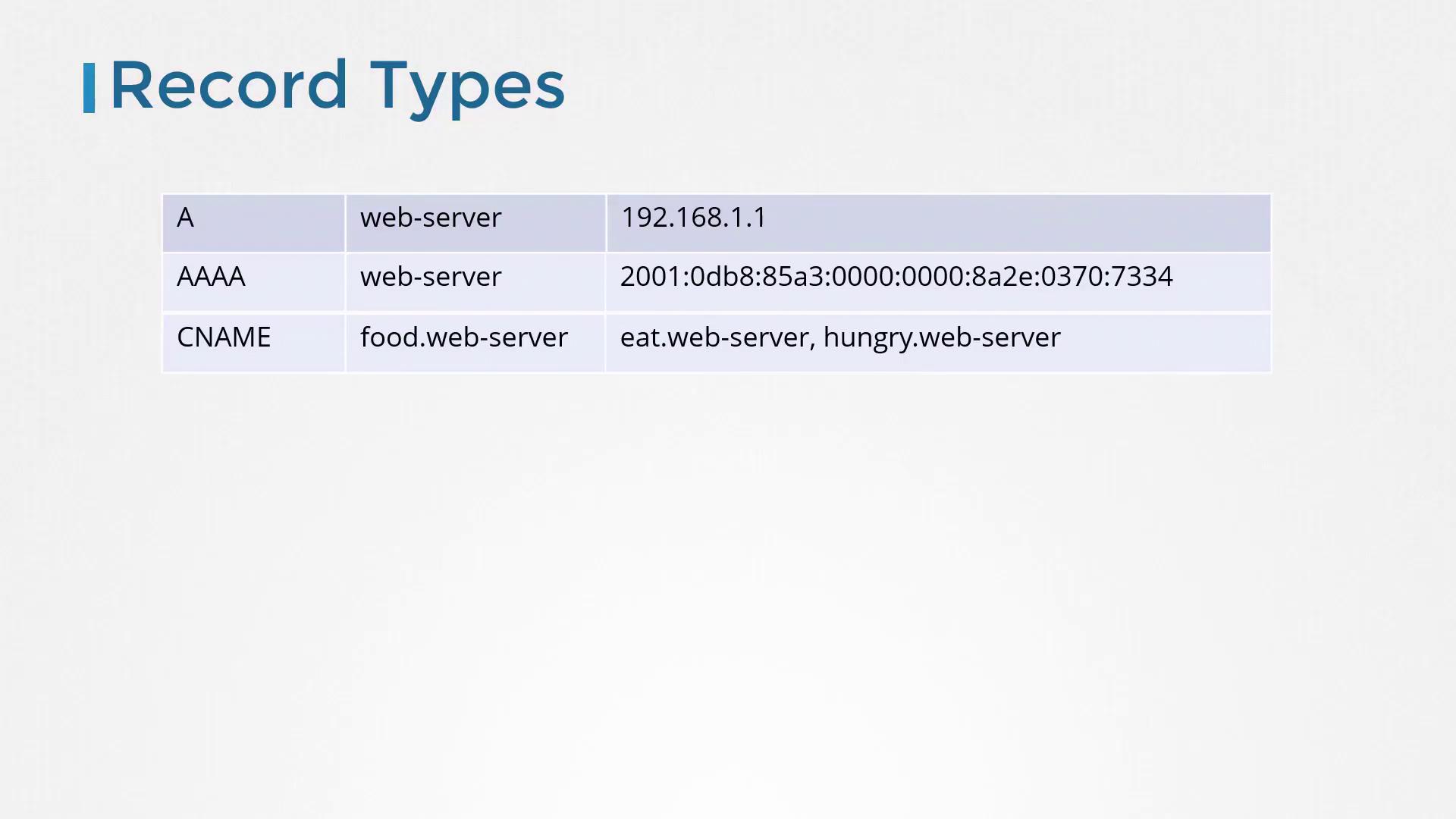DevOps Pre-Requisite Course
Networking Basics
DNS
In this lesson, we introduce DNS on Linux for beginners. We cover basic DNS concepts and demonstrate the essential commands needed to configure and troubleshoot DNS on Linux hosts. By the end, you'll have the opportunity to complete a hands-on lab with DNS challenges directly in your browser.
Imagine you have two computers—A and B—on the same network, with IP addresses 192.168.1.10 and 192.168.1.11 respectively. You can verify connectivity by pinging computer B from computer A using its IP address:
ping 192.168.1.11
Sample output:
Reply from 192.168.1.11: bytes=32 time=4ms TTL=117
Reply from 192.168.1.11: bytes=32 time=4ms TTL=117
Suppose system B provides database services and you want to refer to it by an easy-to-remember name like "db". Attempting to ping "db" immediately, however, results in:
ping db
ping: unknown host db
To resolve this, add an entry to the /etc/hosts file on system A to map the IP address to the name "db":
cat >> /etc/hosts
192.168.1.11 db
Now, pinging "db" directs traffic to 192.168.1.11:
ping db
PING db (192.168.1.11) 56(84) bytes of data.
64 bytes from db (192.168.1.11): icmp_seq=1 ttl=64 time=0.052 ms
64 bytes from db (192.168.1.11): icmp_seq=2 ttl=64 time=0.079 ms
Note
Keep in mind that system A relies entirely on the /etc/hosts entry for name resolution. It does not verify whether system B’s actual hostname (as reported by the hostname command) matches "db".
You can also add multiple aliases for the same IP address. For instance, to associate system B with both "db" and "www.google.com", update the /etc/hosts file as follows:
cat >> /etc/hosts
192.168.1.11 db
192.168.1.11 www.google.com
After this, both names will resolve to 192.168.1.11. Test it with:
ping db
PING db (192.168.1.11) 56(84) bytes of data.
64 bytes from db (192.168.1.11): icmp_seq=1 ttl=64 time=0.052 ms
64 bytes from db (192.168.1.11): icmp_seq=2 ttl=64 time=0.079 ms
ping www.google.com
PING www.google.com (192.168.1.11) 56(84) bytes of data.
64 bytes from www.google.com (192.168.1.11): icmp_seq=1 ttl=64 time=0.052 ms
64 bytes from www.google.com (192.168.1.11): icmp_seq=2 ttl=64 time=0.079 ms
Each time you reference a hostname—whether using ping, SSH, or curl—the system first checks the /etc/hosts file:
cat >> /etc/hosts
192.168.1.11 db
192.168.1.11 www.google.com
ping db
ssh db
curl http://www.google.com
This translation of a hostname to an IP address is known as name resolution. While managing small networks via local /etc/hosts files works well, maintaining consistency becomes difficult as the number of hosts increases.
Important
If a server’s IP address changes, updating the /etc/hosts file on every host can be a major headache. A centralized DNS server eliminates this problem.
Centralizing DNS with a DNS Server
To simplify name resolution in larger networks, you store these mappings on a single DNS server. For example, consider these entries on your centralized DNS server:
cat >> /etc/hosts
192.168.1.10 web
192.168.1.11 db
192.168.1.12 nfs
192.168.1.20 web
192.168.1.21 db-1
192.168.1.22 nfs-1
192.168.1.31 web-1
192.168.1.32 db-2
192.168.1.40 web-2
192.168.1.41 sql
192.168.1.42 web-5
192.168.1.61 web-test
192.168.1.63 db-prod
192.168.1.64 nfs-4
192.168.1.60 web-3
192.168.1.62 nfs-prod
Configure each host on your network to use this DNS server for name resolution by specifying its IP address in the /etc/resolv.conf file. For example, if your DNS server’s IP address is 192.168.1.100, add:

cat >> /etc/resolv.conf
nameserver 192.168.1.100
With this setup, if a hostname isn’t locally resolved via /etc/hosts, the system queries the DNS server. Updating the DNS server’s mappings automatically refreshes host resolution across the network.
Local /etc/hosts entries remain useful for specific purposes. For instance, if you provision a test server that only you need to access, add an entry like this:
cat >> /etc/hosts
192.168.1.115 test
ping test
Output:
PING test (192.168.1.115) 56(84) bytes of data.
64 bytes from test (192.168.1.115): icmp_seq=1 ttl=64 time=0.052 ms
64 bytes from test (192.168.1.115): icmp_seq=2 ttl=64 time=0.079 ms
The DNS resolution order is controlled by /etc/nsswitch.conf. By default, it is set to:
cat /etc/nsswitch.conf
hosts: files dns
This configuration instructs the system to check the local /etc/hosts file first ("files") and then query the DNS server ("dns").
If a hostname isn’t found in either the local file or on the DNS server (for example, www.facebook.com when your DNS does not forward unresolved queries), the ping will fail. To resolve external domains, you can add a public DNS server (such as Google's 8.8.8.8) to /etc/resolv.conf or set your internal DNS server to forward queries.
Consider this scenario: Initially, pinging www.facebook.com fails.
cat >> /etc/hosts
192.168.1.115 test
ping www.facebook.com
Output:
ping: www.facebook.com: Temporary failure in name resolution
Once you add the DNS server in /etc/resolv.conf:
cat >> /etc/resolv.conf
nameserver 192.168.1.100
ping www.facebook.com
Output:
PING star-mini.c10r.facebook.com (157.240.13.35) 56(84) bytes of data.
64 bytes from edge-star-mini-shv-02-sin6.facebook.com (157.240.13.35): icmp_seq=1 ttl=50 time=5.70 ms
The ".com" indicates a top-level domain (TLD) that classifies the website under specific categories such as commercial or network-related.
DNS Hierarchy and Search Domains
Consider the hierarchical structure of Google’s domain. The primary domain is "google.com", while "www" is one of its subdomains. Other subdomains like maps.google.com, drive.google.com, apps.google.com, and mail.google.com represent different Google services. When queried, your DNS server may need to forward the request up the hierarchy—which involves root DNS servers, TLD servers, and authoritative DNS servers—to resolve the domain to the correct IP address.

Similarly, an organization might use a domain such as mycompany.com with subdomains like www.mycompany.com for the public website, mail.mycompany.com for email, drive.mycompany.com for storage, payroll.mycompany.com for payroll services, and hr.mycompany.com for human resources. These DNS records are centrally managed by the internal DNS server.
To simplify internal hostname resolution, you can configure a search domain in /etc/resolv.conf. This allows you to use short names instead of fully qualified domain names. For example:
cat >> /etc/resolv.conf
nameserver 192.168.1.100
search mycompany.com
Now, when you ping a short name like "web", the system automatically appends "mycompany.com" to resolve it:
ping web.mycompany.com
Output:
PING web.mycompany.com (192.168.1.10) 56(84) bytes of data.
64 bytes from web.mycompany.com (192.168.1.10): icmp_seq=1 ttl=64 time=0.052 ms
Attempting to ping "web" without proper search settings may result in a resolution failure:
ping web
Output:
ping: web: Temporary failure in name resolution
You can also list multiple domains in the search configuration to allow the resolver to try several suffixes for a short hostname.
Common DNS Record Types
DNS servers store mappings between hostnames and IP addresses, and these mappings are defined by various record types. Below is a table summarizing common DNS record types:
| Record Type | Example Hostname | Example Mapping |
|---|---|---|
| A | web-server | 192.168.1.1 |
| AAAA | web-server | 2001:0db8:85a3:0000:0000:8a2e:0370:7334 |
| CNAME | food.web-server | Points to eat.web-server, hungry.web-server |
An A record maps a hostname to an IPv4 address, while an AAAA record maps a hostname to an IPv6 address. A CNAME (canonical name) record creates an alias for another domain name—useful for routing multiple names to the same application.

DNS Diagnostic Tools
While ping is a standard tool for checking DNS resolution, utilities like NSLookup and DIG provide more detailed insights.
For example, NSLookup directly queries a DNS server, bypassing local /etc/hosts entries:
nslookup www.google.com
Sample output:
Server: 8.8.8.8
Address: 8.8.8.8#53
Non-authoritative answer:
Name: www.google.com
Address: 172.217.0.132
Similarly, DIG provides comprehensive DNS information:
dig www.google.com
Sample output:
; <<>> DiG 9.10.3-P4-Ubuntu <<>> www.google.com
;; global options: +cmd
;; Got answer:
;; ->>HEADER<<- opcode: QUERY, status: NOERROR, id: 28065
;; flags: qr rd ra; QUERY: 1, ANSWER: 6, AUTHORITY: 0, ADDITIONAL: 1
;; OPT PSEUDOSECTION:
; EDNS: version: 0, flags:; udp: 512
;; QUESTION SECTION:
;www.google.com. IN A
;; ANSWER SECTION:
www.google.com. 245 IN A 64.233.177.103
www.google.com. 245 IN A 64.233.177.105
www.google.com. 245 IN A 64.233.177.147
www.google.com. 245 IN A 64.233.177.106
www.google.com. 245 IN A 64.233.177.104
www.google.com. 245 IN A 64.233.177.99
;; Query time: 5 msec
;; SERVER: 8.8.8.8#53(8.8.8.8)
;; WHEN: Sun Mar 24 04:34:33 UTC 2019
;; MSG SIZE rcvd: 139
As you work through practice exercises, you will configure, view, and troubleshoot DNS on actual systems using these tools.
That concludes this lesson on DNS. Happy learning!
Watch Video
Watch video content
Practice Lab
Practice lab